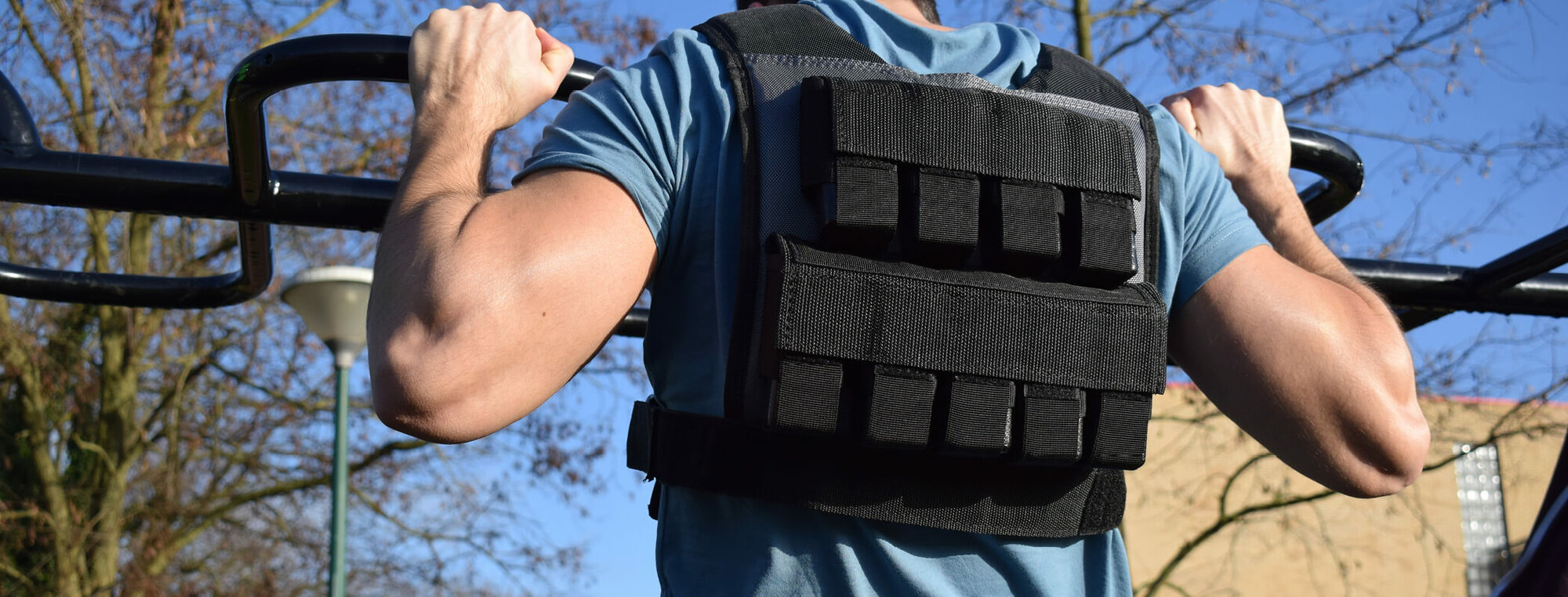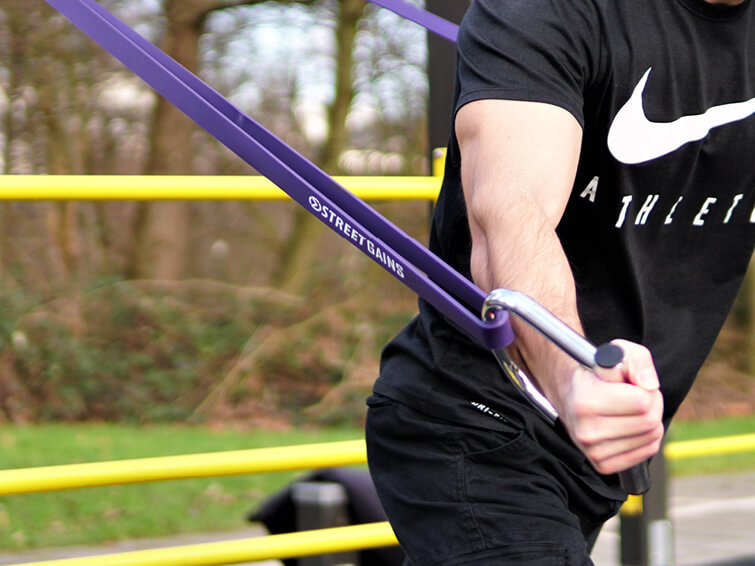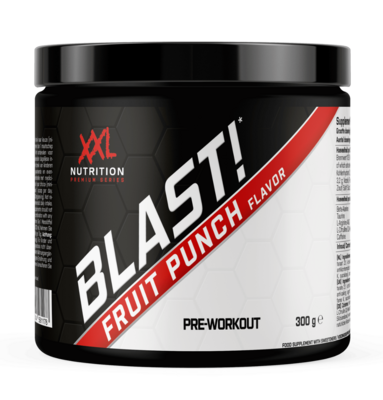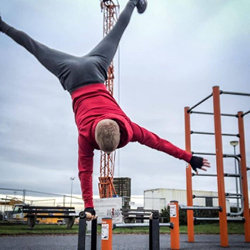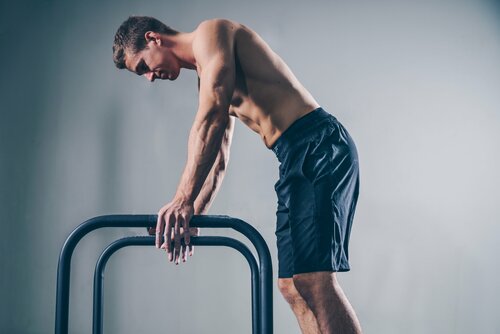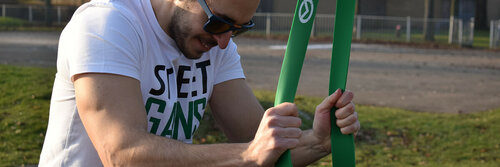Setting up a home gym offers the flexibility to train whenever you want. But what equipment do you really need for an effective workout? In this article, we’ll go over five essential pieces of equipment that will help you build a versatile and complete home gym. Essential equipment for your home gym 1. Multi Grip Pull-Up System The Multi Grip Pull-Up System offers multiple grip options for pull-ups and chin-ups and is designed to be mounted on the wall. It allows you to effectively train your back and arms. You can also attach StreetGains rings or resistance bands to the bar, adding more variety to your workouts. 2. Dip bars The StreetGains Dip Bars are perfect for exercises like dips, which strengthen your chest, shoulders, and triceps. These bars are height-adjustable, making them suitable for various exercises and users. Additionally, they can easily be stored under a bed when not in use. 3. Set of parallettes Parallettes are an excellent addition for bodyweight exercises. They increase your range of motion, enhancing push-ups, L-sits, and handstand exercises. Parallettes help build strength and stability by requiring greater control during your movements. 4. Rings The StreetGains rings, which can be attached to the Multi Grip Pull-Up System, are versatile for exercises like pull-ups, dips, and muscle-ups. They challenge you to develop strength, stability, and coordination while adding a dynamic training element. 5. Set of resistance bands Resistance bands are essential for strength training, mobility, and warm-up exercises. Compact and portable, they can be attached to the Multi Grip Pull-Up System to add resistance to your workouts. Whether you're focusing on strength or flexibility, resistance bands are a versatile addition to your home gym. Tips for setting up your home gym Maximize your space: Choose versatile equipment that can be stored easily, like dip bars and rings. Protect your floors: Use rubber mats or flooring tiles to provide grip and protect your floor. Keep equipment organized: Use racks or holders to keep your equipment neatly stored when not in use. Conclusion Building a home gym doesn’t have to be complicated. With the Multi Grip Pull-Up System, StreetGains Dip Bars, a set of parallettes, rings, and resistance bands, you’ll have all the essential equipment to train your strength, stability, and endurance at home. Start building your home gym today and reach your fitness goals in the comfort of your own space! Visit our webshop for more information about these products.
Lees meer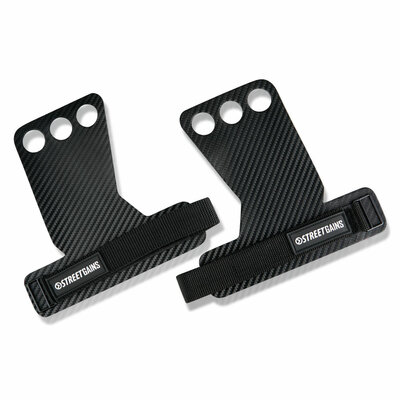
The ultimate hand protection for maximum grip, made from high-quality materials.
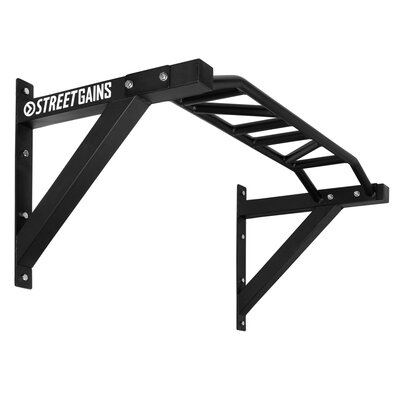
Robust pull-up bar with many handles for indoor and outdoor use.
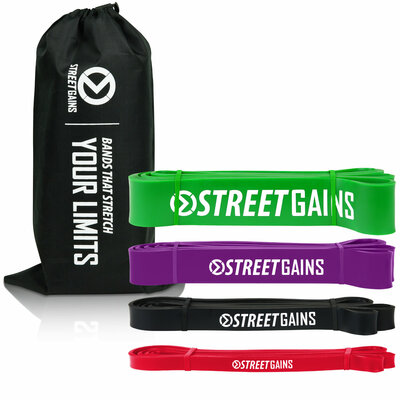
Set consists of four Resistance Bands that help you learn the muscle-up.
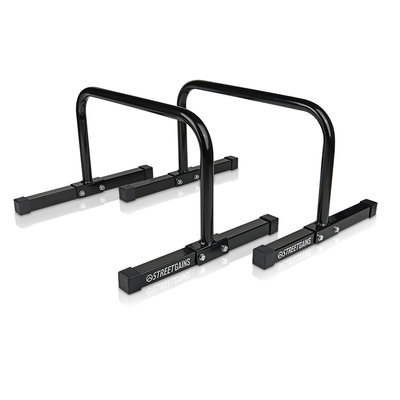
The parallettes have an indestructible steel construction and are equipped with non-slip pads.
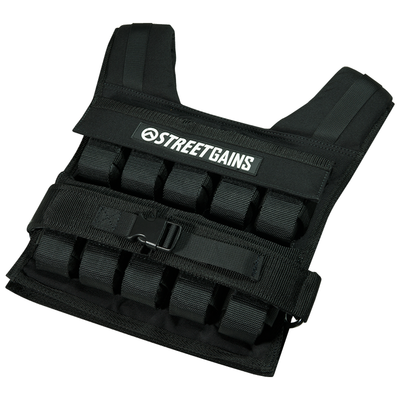
Compact weight vest made of heavy-duty CORDURA® nylon and with an adjustable weight up to 20 kg.
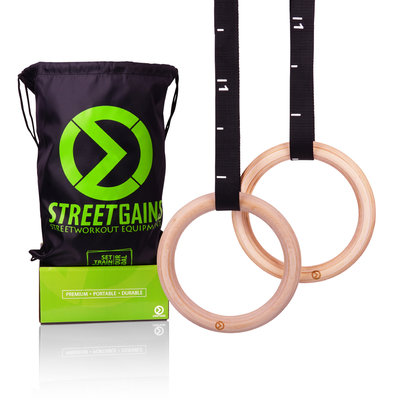
Premium wooden gymnastic rings made according to the requirements of tje FIG.
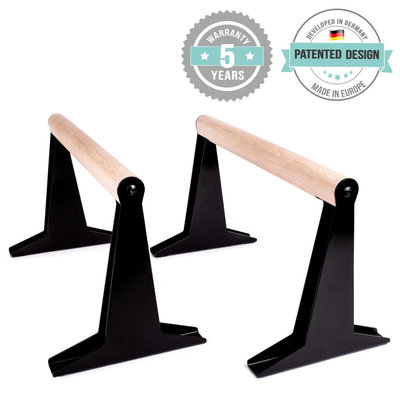
The ergonomic wooden handle of the medium high parallettes offers a perfect grip during training.
About StreetGains
The number 1 calisthenics store in Europe
StreetGains is the online store specialized in calisthenics and bodyweight fitness. A place where you can get all your calisthenics equipment, a place focused on you. With our products we hope to bring more possibilities, variations and challenges to your workout, so that maximum results and pleasure can be achieved. This to help you to come closer to your personal sports goals. Whether you are young or old, beginner or expert: with the help of StreetGains gear everyone can do it! #ReachYourGoal
What is calisthenics?
Calisthenics is a form of sports in which you use your own body weight as resistance. A sport that has grown enormously in popularity in Europe the past few year. The purpose of calisthenics is to increase muscle mass, strength, mobility, flexibility and endurance. Well-known exercises are: pull-ups, push-ups and dips. Calisthenics is usually performed outside. This allows you to meet new people and learn from each other exercises that you have not seen before. You inspire and motivate each other, so that it remains fun and challenging.
Calisthenics equipment for all levels
StreetGains supplies the right equipment for every level of athlete. Beginners often have the need for ways to ease exercises. For this level of athlete, a resistance band can be a perfect solution. These bands can make a heavy exercise, such as the pull-up, a lot easier. On the other hand, advanced athletes look for new variations and challenges to add to their workout. In this case, rings or a weight vest can be a necessary addition. We also have a wide range of parallelettes, chin-up bars, speed ropes, chalk and a lot more!
Always stay informed?
Subscribe for our newsletter.
Latest blog posts

In today’s world, many workplaces still revolve around long hours of sitting behind a desk. The importance of movement and physical activity in the workplace is becoming increasingly clear, not only for employee health but also for productivity and overall well-being. One of the most accessible and effective forms of exercise that a company can embrace is calisthenics. Calisthenics is a form of strength training that uses only your body weight. Think of exercises like push-ups, pull-ups, squats, and planks. It's simple, efficient, and can be done anywhere—even at the office. Why calisthenics in the workplace? 1. Health and vitality Sitting for long periods poses health risks, such as back pain, weight gain, and an increased risk of cardiovascular disease. By integrating calisthenics into the workplace, you can significantly improve the health of your team. Short bursts of movement during the day help boost circulation, increase energy levels, and strengthen muscles. 2. Increased productivity Research shows that physical activity boosts productivity. When employees regularly take short, intense exercise breaks, their brains are reactivated. A refreshing calisthenics session ensures that they return to work focused and motivated. It also reduces stress and improves mental clarity. 3. Team building and morale Calisthenics is a great way to connect teams. Group workouts foster a sense of unity, which is essential for effective collaboration. By taking on new challenges together, such as improving pull-up techniques or completing a group workout, a positive group dynamic is created. 4. Accessibility One of the greatest advantages of calisthenics is that it doesn’t require expensive or complex equipment. With simple products like pull-up bars, rings, and weight vests, employees can get started right away. These products are easy to install in the workplace and take up minimal space, transforming even a small area into a mini training station. How to start calisthenics at the workplace Integrating calisthenics into your office is easier than you might think. Here are some practical tips: Create a fitness corner: Install a StreetGains multi grip pull-up bar in a corner of the office or break room. This makes it easy for employees to work out between meetings or during lunch breaks. Organize group workouts: Encourage employees to do short workouts together. Simple circuit training, such as alternating pull-ups, squats, and push-ups, works great. You can even make it fun by organizing weekly challenges like “Who can do the most pull-ups?” Use weight vests: For employees looking for an extra challenge, provide a StreetGains weight vest. This adds resistance and makes simple exercises like squats or lunges more intense. Incorporate resistance bands: StreetGains resistance bands are perfect for making exercises more accessible or challenging. They can help with pull-up assistance or add resistance to squats and lunges. Push-up bars for variety: StreetGains push-up bars provide extra grip and greater range of motion during push-ups, offering more intense workouts and exercise variation. Offer flexibility: Make sure calisthenics remains low-threshold at the office. Allow employees to participate at their own pace and level. Calisthenics products for the office In our webshop, we offer various products that are ideal for use in the workplace: StreetGains multi grip pull-up bar: This versatile pull-up bar can be easily mounted on the wall or ceiling. It’s perfect for pull-ups, chin-ups, and other exercises. With different grip options, employees can target various muscle groups. StreetGains rings: These rings are perfect for calisthenics and strength training. They offer a wide range of workout possibilities, such as dips, pull-ups, and core exercises. StreetGains weight vest: This vest adds extra resistance to exercises, making workouts more challenging without needing additional equipment. StreetGains resistance bands: Ideal for assisting pull-ups or adding resistance to exercises like squats, lunges, and core workouts. StreetGains push-up bars: These sturdy bars provide additional stability and a greater range of motion for push-ups, resulting in a more intense workout. Conclusion Calisthenics offers a simple, cost-effective way to improve the health, productivity, and morale of your team. By purchasing a few essential products and promoting a culture of movement in the workplace, you can have a huge positive impact on your employees and their environment. Want to integrate calisthenics into your workplace? Check out our products and take the first step toward a fitter, healthier, and more productive team!
Lees meer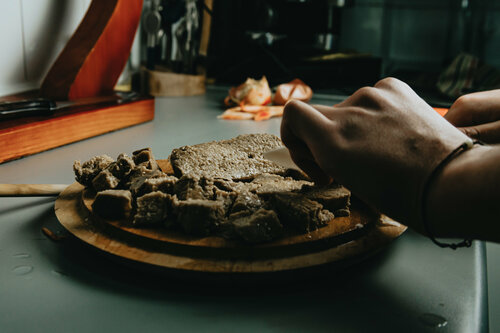
Calisthenics is a popular form of training that uses body weight to build strength and endurance. Its versatility and focus on functional strength make it appealing to many, from beginners to experienced athletes. However, to make real progress and ensure optimal recovery, your diet plays a crucial role. In this article, we’ll explore how to align your nutrition with calisthenics to achieve the best results. 1. Proteins: building blocks for muscle repair and growth Proteins are essential for muscle repair and growth. During calisthenics, you engage multiple muscle groups, often creating micro-tears in the muscle fibers through intense exercises like pull-ups, dips, and squats. To repair and grow stronger, you need adequate protein intake. What to eat: Go for protein-rich sources like chicken, fish, eggs, lean dairy, or plant-based options like tofu, tempeh, and beans. How much: Aim for 1.6-2.2 grams of protein per kilogram of body weight per day, depending on your training intensity. Timing: Try to consume a protein-rich meal within an hour of your workout. This helps your muscles begin the recovery process immediately. 2. Carbohydrates: fuel for your workouts Carbohydrates are the primary source of energy for your body, crucial for high-intensity exercise. They replenish glycogen stores in your muscles, allowing you to sustain energy levels for each workout session. What to eat: Choose complex carbohydrates like oats, whole-grain pasta, quinoa, sweet potatoes, and fruit for sustained energy and balanced blood sugar. Timing: Eat a meal with carbs 1-2 hours before your workout. This gives your body time to convert the carbs into energy. 3. Fiber: essential for a healthy digestion A healthy digestive system is vital for nutrient absorption and maintaining steady energy levels. Fiber supports a balanced gut microbiome and helps regulate blood sugar. What to eat: Incorporate fiber-rich foods like vegetables, fruit, whole grains, beans, and nuts. How much: Aim for 25-30 grams of fiber per day. Avoid excessive fiber just before a workout, as it may cause discomfort. 4. Healthy fats: energy and hormonal support Healthy fats are crucial for hormone production, brain and heart health, and also serve as an energy source, especially during prolonged exercise. Fats slow digestion, helping you feel full for longer. What to eat: Include sources of healthy fats like avocado, nuts, seeds, olive oil, and fatty fish (such as salmon and mackerel). How much: Aim for fats to make up 20-30% of your total calorie intake. Avoid large amounts right before training, as fats can slow down digestion. 5. Hydration: stay hydrated for peak muscle performance Hydration is essential for muscle performance and recovery. In calisthenics, where balance and stability are critical, dehydration can impair muscle control and endurance. How much: Aim for at least 2-3 liters of water per day, depending on body weight and training intensity. Hot weather or intense training may require even more. Timing: Start your day with a glass of water, and drink regularly before, during, and after workouts. Limit sugary drinks and caffeine, as these can be dehydrating. 6. Meal timing: energized and ready for every workout The timing of your meals affects your energy levels and performance. A well-timed meal keeps you fueled without feeling weighed down. Pre-workout meal: Eat a balanced meal with carbs and protein 1-2 hours before training, like a banana with peanut butter or whole-grain toast with chicken. This gives you energy without a heavy feeling. Post-workout meal: Eat a meal rich in protein and carbs within an hour after training to replenish glycogen and repair muscles. A smoothie with protein powder and fruit or a wrap with chicken and vegetables are great choices. 7. Supplements: optional support for calisthenics athletes Although whole foods should be the foundation, certain supplements can provide extra support for calisthenics athletes looking to enhance their performance: Protein powder: An easy way to increase protein intake, especially post-workout. Creatine: May help improve strength and endurance, useful for calisthenics. BCAAs (Branched-Chain Amino Acids): Can reduce muscle breakdown during longer training sessions. Conclusion: optimize your diet for the best results For maximum progress in calisthenics, diet and training are inseparable. Ensure adequate intake of proteins, carbohydrates, healthy fats, and fiber, and pay attention to hydration and meal timing. By following a balanced and mindful approach to nutrition, you’ll not only become stronger but also recover faster and see sustained progress.
Lees meer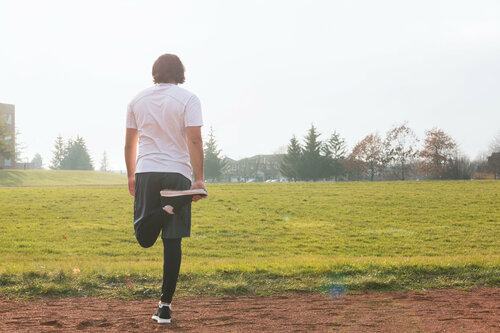
A proper warm-up for calisthenics is not only important to prevent injuries but also to prepare your body for the challenges ahead. Calisthenics is an intense form of training where you often use your own body weight to develop strength, flexibility, and endurance. A solid warm-up ensures that your muscles are flexible, your joints function properly, and your heart rate gradually increases, allowing you to get the most out of your workout. Ideally, a warm-up lasts between 10 and 15 minutes and consists of a combination of light cardio and different types of stretching. Let’s take a look at the best steps for an effective calisthenics warm-up. 1. Start with light cardio Before stretching, it's important to warm up your body with light cardio. This raises your heart rate and warms your muscles, significantly reducing the risk of injury. Some examples include: Jumping jacks Light jogging Brisk walking These exercises improve blood circulation and ensure your muscles receive oxygen, preparing you for more intense movements. 2. Dynamic stretching After cardio, it’s time to prepare your muscles for the movements you’ll be performing. Dynamic stretching is a popular choice for calisthenics because it actively warms up and strengthens the muscles. This type of stretching involves smooth, controlled movements that lengthen your muscles while keeping them active. Some effective dynamic stretches for calisthenics include: Head-to-knee stretch Knee push-ups Leg swings (for the hip flexors) Arm and back swings Squats (for the legs) The key with dynamic stretching is to perform the movements in a controlled manner and start with low intensity to prevent muscle strain. 3. Static stretching After dynamic stretching, you can move on to static stretching. This involves holding a specific position to lengthen the muscle. Unlike dynamic stretching, where you stay in motion, static stretching focuses on holding the stretch to improve flexibility and relax your muscles. Here are some static stretches to target the muscles you'll use during your calisthenics workout: Hamstring stretch: Sit with your legs extended in front of you, bend your upper body toward your knees, and hold the stretch. Quad stretch: Stand upright and pull one foot toward your buttocks. Repeat with the other leg. Chest stretch: Stand with your feet shoulder-width apart, stretch your arms behind you, and push your chest forward. Hip flexor stretch: Kneel on one knee and push your hips forward. Repeat with the other leg. Shoulder stretch: Pull one arm across your body to stretch your shoulder muscles. Hold each stretch for 15-30 seconds—this is the ideal duration to keep your muscles in a stretched position and allow them to relax. 4. Don’t forget the cool-down A good warm-up is crucial for any workout, but a cool-down is just as important—especially after an intense calisthenics session. Your muscles have been working hard, and adding a cool-down helps them recover, reduces muscle soreness, and lowers the risk of injury.
Lees meer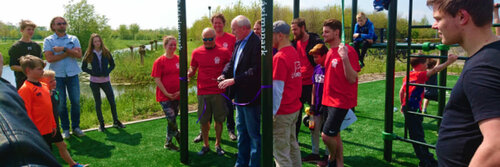
It took a while but then you really have something. The sporty Maximapark now also has a calisthenics and boot camp park. The park on the Ribbon was created on the initiative of five Leidsche Rijners. The official opening took place last Saturday and we were there! The program Alderman Kees Geldof was also present and was allowed to cut the red ribbon. After the official opening of the streetworkout park, the Calisthenics Zeist team gave an impressive demo and showed the possibilities of the park. Then the audience could work up a sweat. Two competitions were held. Who could hang around the bars the longest and who could perform the most push-ups. The price? A bright green goody bag from StreetGains :). To conclude, an interesting calisthenics workshop could be followed, provided by Papito, Thijmen and Bo from Calisthenics Zeist. Calisthenics training in the Maximapark The streetworkout park is very active and various training sessions are regularly organized. For example, if there are sufficient registrations, calisthenics training takes place on Mondays. You decide for yourself what you think the training is worth and want to pay for (pay what you want principle). Visit the Facebook-page of Calisthenics Utrecht Leidsche Rijn for more information or to register for a training.
Lees meer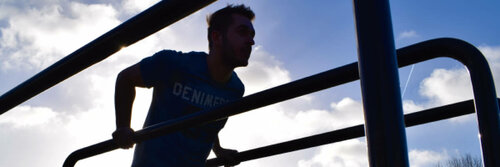
In this article we share two calisthenics schedules especially for the novice calisthenics athlete. This is a follow-up to our previous blog post 'how to: starting with calisthenics'. In it we discussed how to start with calisthenics and what the five basic exercises are. In this article we will explain how to incorporate these basic exercises into a good training schedule. We therefore recommend that you first read the 'how to: start with calisthenics' before starting this article. Calisthenics Beginner Schedule # 1 The first calisthenics schedule is a fun and challenging schedule that is different from most schedules. The idea behind this schedule is that you start with a difficult variant of an exercise. You perform this as often as possible without taking a break. When you have given everything and can no longer perform repetitions, you switch to the easier version of the exercise. The diagram shows that you start with the normal push-up (on all fours) and then switch to knee push-ups. Exercise Repetitions Sets Resistance Band Pull-ups Max 1 Australian Pull-ups Max 1 Push-ups Max 1 Knee Pus-ups Max 1 Bench Pistol Squats Max 1 Squats Max 1 (Tucked) L-Sit Hold Max 1 (Tucked) L-Sit Raises Max 1 Dips Max 1 Bench Dips Max 1 Calisthenics Beginner Schedule # 2 The second calisthenics schedule is a more traditional training schedule. It contains five exercises. You perform three sets of each exercise. Rest for approximately two minutes between each set. Exercise Repetitions Sets Australian Pull-ups 12 3 Push-ups 10 3 Bench Pistol Squats 10 3 Bench Dips 15 3 (Tucked) L-Sit Raises 12 3
Lees meerHave you just started or are you thinking about starting calisthenics? Are you looking for a good beginner workout? We have added this article to our calisthenics blog especially for you. In this article we will explain, among other things, which exercises you can start with, how to master these exercises and what you should consider further. The purpose of the 'How To: start with calisthenics' is to lay a solid foundation, by mastering the basic exercises of calisthenics. Only when you have mastered these well, you can focus on the more advanced calisthenics exercises, such as the muscle-ups and handstand push-up. Before you start with calisthenics When you are just starting out with calisthenics, it is important to build it up slowly and not to rush. Your muscles, tendons and the rest of your body have to get used to the new load. In addition, it is always important to start every workout with a good warm-up. During the warm-up it is important to warm up the muscles and tendons and to get the blood circulation going. So don't skip this. A good warm-up will have a positive effect on your strength and endurance during the rest of your workout. A skipping rope can help with this. We recommend the Speed Rope Survival. The steel ball bearing system makes the skipping rope run smoother and faster than an ordinary skipping rope. It is not for nothing that martial artists use this during their strength and conditioning training. The five basic exercises of calisthenics Always remember that it is important to exercise your entire body, including your legs! In this workout, attention is therefore paid to each body part: back, chest, shoulders, arms, core and legs. The calisthenics beginner workout consists of the five basic calisthenics exercises, namely push-ups, pull-ups, dips, pistol squats and L-sits. Make sure you have mastered each step before starting the next step. 1. The push-up We start with push-ups, or push-ups. It is perhaps the most famous of the five basic exercises we will go through in this article. The push-up mainly requires strength from the chest, shoulders and triceps. Step 1: Knee push-ups The first step to master the push-up is to perform knee push-ups. Get on your knees and place both hands shoulder-width apart on the floor. This is the starting position. Now slowly sink down until your chest almost touches the floor. Then press up again to the starting position. Make sure your body stays still throughout the exercise and you only move your arms. You can use these push-up supports to relieve your wrists. Step 2: Incline push-ups When the knee push-ups are easy for you, you can proceed to the incline push-ups. To do this, find an object that is higher than the ground. For example a wall, staircase or bench. We use a rod in the example photo below. Stand up straight and place your hands on the chosen object. Keep your body in a straight line and slowly sink down. Then press up again. Start with a relatively high object and slowly work your way up to a lower object until you don't need an object at all. 2. The pull-up The pull-up, also called a pull-up, is an excellent exercise to target the back muscles and biceps. It is an exercise that requires a lot of strength. It may therefore take a while before you master it. So don't give up right away and perform the following steps as best you can. Only then will you succeed! Step 1: Australian pull-ups We start with the Australian pull-ups. This variant of the pull-up is an excellent way to work towards the pull-up. With your back pointing to the floor, hang under a horizontal bar. Just like you can see in the picture below. Grasp the bar slightly wider than shoulder width. This is the starting position. Draw your chest towards the bar. Then slowly lower back to the starting position. The lower the bar you use, the more difficult the exercise will be. Tighten your abs during this exercise and make sure your body is in a straight line. Step 2: Australian pull-ups small/wide grip We stick with the Australian pull-ups for a while, but now switch grip positions. Stand in the same position as in the first step, but hold the bar very wide or very narrow. Step 3: Resistance band pull-ups In this step we are going to use resistance bands. The Pull-Up Pack to be precise. This is a specially composed package that will help you perform the perfect pull-up step by step. The package consists of three resistance bands, each with a different resistance. Attach the band to a high bar. Then step on the band with both feet and grasp the bar with your hands. Pull yourself up slowly and in a controlled manner. Hold this position for one second and then slowly lower yourself back down. You start with the strongest tire in the package and work towards the lightest tire. When you can do a few reps with the lightest band, it's time to do the pull-up unassisted. 3. The dip The third basic calisthenics exercise is the dip. You usually perform dips on two parallel bars, but you can also use, for example, two chairs. Make sure that they are sturdy and stable. Dips are an excellent exercise for your triceps and chest muscles. Step 1: Behind the back dips First, find a chair, staircase or bench on which you can perform the 'behind the back dips'. With both hands behind your back, put your palms on the object, just like in the photo below. Now slowly sink down to the point that your elbows are at a ninety degree angle. Only use your arms and keep the rest of your body still. Now push yourself back up, so that you get back to the starting position. Step 2: Behind the back dips with elevated legs This exercise is a challenging variation of the first step. You perform the 'behind the back dips' again, but now you put your legs on an elevation. Step 3: Negative dips Time for the real work! Stand between two parallel bars. You can use the Adjustable Equalizer for this. Put your hands on the bars. Jump up so that both feet are off the ground and your full body weight is supported on your arms. This is the starting position. Now lower as slowly as you can until your elbow is at a ninety degree angle and your feet are touching the floor. Then jump up again so that you get to the starting position. You will likely drop down quickly and uncontrollably at first. The more you perform the exercise, the better. Finally, try to push off less and less hard when you want to get into the starting position. This is to use more power from your arms instead of your legs. 4. The pistol-squat We have come to the legs. Many find this the least enjoyable part of the body to train. Still, it is very important not to skip this. Exercising your legs ensures that more growth hormones and testosterone are released in the body. This stimulates muscle growth throughout the body. The pistol squat is a one leg squat. The other leg points straight forward, making the body look like a gun. Hence the name pistol squat. Step 1: Bench Squats We start easy. Find a playpen, chair or just a park bench. Stand in front of the object with your back to it. Put your feet shoulder width apart. This is the starting position. Now slowly bend your knees until you are sitting on the bench. Then you get up again so that you come back to the starting position. Make sure your knees are not too far over your toes and try to push from your heels as you squat. Find a lower and lower object until you can reach deep enough that your knees are at a ninety degree angle. Step 2: Explosive squats We are now removing the object from behind us. Squat down as deep as you can. Then jump up as explosively as possible, so that your feet are off the ground. As this improves, try to pull in your knees as you jump up. Step 3: Bench pistol-squats In this step we again use a bench, box or chair. Stand on one leg and extend the other leg in front of you. This is the starting position. Now squat slowly down until you are on the object. Go back up to the starting position. To maintain your balance, you can stretch your arms forward during this exercise. Step 4: Assisted pistol-squats Now get the object from behind you. Perform the pistol squat while supporting yourself with one arm on a pole or resistance band. Try to lean less and less on your arm and get more power out of your leg. Do this until it succeeds without additional support. 5. The L-sit The L-sit is a static position that you hold for a few seconds. Like the dips, you perform the L-sit on two parallel bars. You can use the Adjustable Equalizer for this again. The L-sit requires strength in the abdominal muscles, but your shoulders and arms must also be strong enough to hold the body weight. The name L-sit comes from the posture you adopt. It resembles the letter “L” from a side view. Step 1: Knee raises Stand between two parallel bars. Grab them with both hands and jump up. You have your legs hanging straight down and you rest on the bars with outstretched arms. This is the starting position. Bend your knees and bring your legs up slowly and controlled, to the point that they are parallel to the ground. Now lower your legs back to the starting position. Step 2: Tucked L-sit hold Do the first step again, but try to hold the legs at the top for a few seconds. Step 3: Leg raises Do the first step again, but instead of bending your knees, now keep your legs fully extended. Step 4: Single leg L-sit You are just one step away from a full L-sit. Assume the starting position, but with the legs out in front of you and your knees bent ninety degrees. Fully extend your left leg while keeping the other leg bent. Try to hold this position for as long as possible. If this is no longer possible, you switch legs. A set of Steel Parallettes can be useful for this exercise. De eerste stap is gezet. Je hebt de 'How To: starten met calisthenics' gelezen. Als het goed is ben je een stuk wijzer geworden en weet je wat je nu te doen staat. Tijd om te beginnen! Ga naar buiten (of binnen) en ga ervoor. Wil je weten hoe je deze oefeningen in een workout gebruikt? Lees dan het artikel: calisthenics beginner schema . Daarin geven wij je twee soorten beginner trainingsschema's, waarin je precies ziet hoeveel sets, reps en oefeningen je moet uitvoeren. Zet door en geef niet op totdat jouw doel bereikt is. #ReachYourGoal
Lees meer



